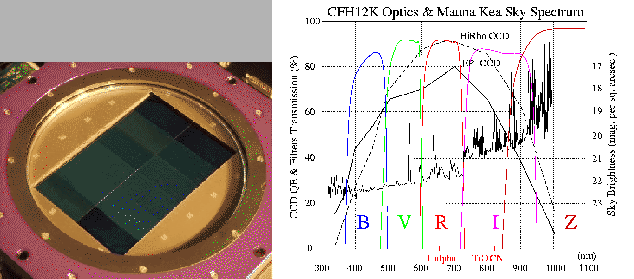The CFHT is located on Mauna Kea at 4200 m , the most volcano of the archipelago of Hawaii. This observatory gains from a very black sky and offers especially a remarkable quality of image which leads this site to be the largest optical and infra-red observatory of planet. The CFHT began its observations in 1980; its equatorial mounting shelters a primary education mirror of 3.6 m, large for the time, but modest today. With its successive cameras (MOCAM 1994, UH8K 1998, CFH12K 1999, Megacam 2003), this telescope was a pioneer in the field of the cameras with large field.
Imagor CFH12K takes seat with the primary education hearth of the telescope. Its focal plan (fig 7.1 ) consists of 2 lines of 6 CCDs of 2048x4096 pixels. The with dimensions one of a pixel covers ![]() on the sky, with the result that the stars cover at least 3 pixels of
width with middle height, even under excellent conditions of
observation. The rectangular mosaic thus covers
on the sky, with the result that the stars cover at least 3 pixels of
width with middle height, even under excellent conditions of
observation. The rectangular mosaic thus covers ![]() pixels (from where its name), and it is read in a little less than one
minute. The instrument arrived on the sky during 1999 and the majority
of the supernovæ with great redshift discovered on the
ground were it with him. Several factors explain it: the focal plan
covers a third of square degree; the effectiveness of its CCDs (figure 7.1 )
is particularly good out of I compared to the other instruments of its
category; the quality of image obtained regularly on the site is about
0.7' '.
pixels (from where its name), and it is read in a little less than one
minute. The instrument arrived on the sky during 1999 and the majority
of the supernovæ with great redshift discovered on the
ground were it with him. Several factors explain it: the focal plan
covers a third of square degree; the effectiveness of its CCDs (figure 7.1 )
is particularly good out of I compared to the other instruments of its
category; the quality of image obtained regularly on the site is about
0.7' '.
Other means of discovering supernovæ Ia with very large Z appeared since 1999: system ACS on Hubble and the Subaru telescope of 8m with a camera of 1/4 of square degree. Instrument CFH12K is not exploited any more with the CFHT today: it was replaced by the MegaPrime instrument, was equipped with the Megacam camera which covers 1 square degree, and is equipped with a mechanism called `` tip-tilt '' making it possible to compensate for the total movements of the image in the focal plan (due for example to the effect of the wind on the telescope). This surface makes it possible in theory to probe the same volume of universe as Subaru of 8m in an equal time of observation.
 |
We sought supernovæ with the CFHT since the autumn 1999. I in very took part in 4 research campaigns to the CFHT. Two research campaigns to very great redshifts (in spring 2001 and 2002) and two campaigns with shifts towards the intermediate red (around 0.2) in 2000 and 2001.
Now let us describe how are prepared, then realized the observations.